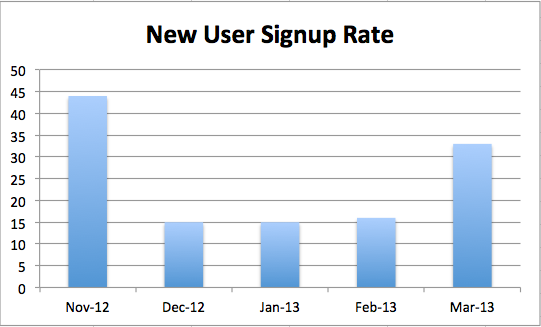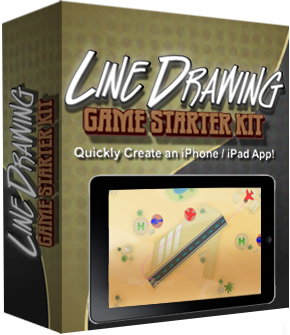KoboldTouch has been on sale for exactly 5 months (released: Nov 1st, 2012). Time for a “numbers post”.
Let’s start with new user signup rates and popular pricing plans before I get to reveal actual and projected revenues.
New User Signup Rate
With a build-up of anticipation, the first month is always noticably on the positive side. If you ignore that first month, you’ll notice that signup rate has been very steady from December through February when it suddenly doubled in March.
This chart shows the number of new users who signed up to any of the pricing plans, with refunds already deducted:

The actual “new user” numbers (not including refunds) for each month are:
- Nov 12: 44
- Dec 12: 15
- Jan 13: 15
- Feb 13: 16
- Mar 13: 33
I believe the reason for the influx of new users in March is two-fold: first I introduced the 1-Month billing plan in Mid-February. And around the same time frame I started hosting the KoboldTouch documentation and KoboldTouch Sales Pitch on www.koboldtouch.com. Continue reading »
For one week only (until Tuesday, December 18th) CartoonSmart runs an exclusive offer for Learn Cocos2D readers:
You get 50% off on the Angry Ninjas, Wave Attack and Awesome E-Book Starter Kits Bundle!
The bundle also includes several Tutorial Videos plus free bonuses: the Isometric Pixel Art Tutorial for Photoshop, the royalty free Vector Art Collection and the first 120 pages of the interactive Cocos2D iOS Game Programming iBook.
The iOS App Development & Starter Kit Bundle normally sells for $100 but you can get it for $49.95 until Tuesday, December 18th.
This is an affiliate link - if you make a purchase I’ll receive a commission. It’ll help me pay off my new iMac (still working with a 2009 model). 
Line-Drawing Starter Kit still 50% off
While I’m at it: my Line-Drawing Starterkit’s Xmas Sale (50% off to $49.95) still has some of the 100 coupon codes left!
I keep forgetting that if I don’t keep mentioning it, sales slow down dramatically. It’s called marketing (in my case: not doing enough of it). If you have a product that doesn’t sell as much as you expect - perhaps you need to mention it more? You would be surprised how much of a difference frequent blog posts or tweets can make.
So here you go. This new iMac is rather expensive. 
 So you have this website going or some source code on github, and like to earn a few bucks. Donations, right? Hold on, there are a couple things you should consider before you add that Donate button!
So you have this website going or some source code on github, and like to earn a few bucks. Donations, right? Hold on, there are a couple things you should consider before you add that Donate button!
UPDATE: If you prefer a concise, to the point summary of this post, you should read the follow-up post The 10 Golden Rules for a Donate Button.
In case you haven’t noticed, you won’t find a Donate button here or on my other websites. It may seem strange that the guy who never had a donation button of all people should write a guide to the donation button.
I consciously decided against having a donation button. You’ll find a number of reasons in this post, and maybe at the end of it you come to agree with me that Donate buttons are over-used, and the more developers offer them the fewer donations reach those developers who actually need and/or deserve donations the most.
I also wrote this as guidance particularly for individual indie or open source developers who are accepting donations or considering to do so, because donating to an individual is fundamentally different than donating to a (charitable) organisation or a software project (team) as a whole. You will also get some ideas on how you can improve your donation acceptance rate and which alternatives for voluntary compensation and appreciation exist.
Rule Number 1: Be a charity or a business. Never both!
I sell commercial products, both my own and third party products for which I receive a commission fee for each sale. I am self-employed, I make my living from those products and a few select contract jobs for people I know personally. It is fair to say that I’m running a business.
For me the question of whether I should ask for donations boils down to this: should a business be asking for and accepting donations? Continue reading »
 It seems like a no-brainer to most computer-affiniados and gamers: eventually, all video games will be distributed online. The question is only, when?
It seems like a no-brainer to most computer-affiniados and gamers: eventually, all video games will be distributed online. The question is only, when?
To retailers this seems to be a whole different story. Most of them are in denial, as I can tell from occasionally reading retail game publishing magazines. They’ll be in for quite the surprise in about 10 years, when it will be obvious even to the blind-folded that boxed retail games will soon be a thing of the past. Alongside Blu-ray movies. It is inevitable, as video games and movies alike are moving towards their most natural distribution media format: instant digital home delivery.
Not only will this reduce inventory risks for publishers, it also cuts out the retail middle-man, allowing direct to consumer sales with full control over pricing and availability. With all the advantages of tracking each user’s usage and profile information for marketing purposes. At the same time conveniently disallowing or at least automating the consumer’s rights to re-sell or lend digital products or issue refunds. Neither Floppy Disks nor Optical Media have offered such compelling advantages to media producers.
But first, let’s consult the history of video game distribution before analyzing what it can tell us about the future. One thing I can say with conviction in advance: retail stores selling physical games and movies will be as commonplace in the 2030s as are Vinyl record stores today.

Beginning today until and including Dec 26th January 1st 2012 the Line-Drawing Game Starterkit is only $49,50 instead of $99,00 (50% off).
Just enter this coupon code when you make the purchase:
MERRYXMAS
Merry Xmas everyone - you deserve it! 
PS: I’ll be practically offline until the first week in January, but I’ll make sure to have a short iDevBlogADay post ready for you on Dec 29th.
I’ve been told that some of you won’t be able to purchase the Line-Drawing Starterkit during the 50% Easter Bunny special sales period if it ends as planned on April 27th (today). I extended the 50% off coupon code event during Easter until May 3rd, so that you’ve had time to cash in your paycheck and/or return from your Easter holiday vacation.
Check the Line-Drawing Starterkit product page for the coupon code. It’s (almost) impossible to miss.
PS:
Seriously, what kind of game developer are you if you’re going on a holiday vacation? For a whole week! Aren’t you supposed to be working yourself to death trying to finish that Quadruple-A game in time for Xmas? And this year you’re really, really going to finish it - not like the previous two years? It says so in your contract.
Sheesh, the kids these days. No idea what working hard means … 😀
Today it was exactly 6 months since I made the first sale of my Line-Drawing Game Starterkit for Cocos2D. I just glanced at the number labelled “Total” in the Plimus control panel: $18,479.05 … all of this from a single product over a period of 6 months!
No Product Launch Formula
I wish I could tell you exactly how to reproduce that level of success. I certainly did not implement the widely publicized and so called product launch formula. I’m sure PLF is valuable but the way it’s being sold makes it a scam to my mind. Why? Because it’s sold only once or twice a year, you can never just buy it, you have to wait for it, and when it goes on sale, people are more than happy to pay an outrageous price for something they could get much cheaper from reading the proper books and applying some common sense. That’s just a side note.
I also have to admit, I have no hard data where my customers are coming from other than they’re from all over the world. Or why each of them is buying or why some of them are interested but end up not doing it. Some will have followed me for quite a while, some found my website via google, others got wind of it through word of mouth and most recently they may have read about the Starterkit in my Learn Cocos2D book.
For the most part I have only informal data that I can share.
Little hard data
Thankful customers writing me that this was exactly what they’ve been looking for, and why. Only 3 refunds if I recall correctly, two were expecting something different and another one found Corona shortly after buying and decided to use Corona over Cocos2D, so he wasn’t going to use my Starterkit. As far as I can tell, most customers are not companies or teams of people but individual developers.
The level of support requests I received were minimal. I estimate that less than 10% of all customers contacted me for support, and almost all support incidents were solved after exchanging one or two emails. Most issues were caused by the fact that I didn’t include Cocos2D with the download, so they were mostly Cocos2D version mismatches and incorrect project setups. I definitely learned from that and will be including Cocos2D in all future versions of the Starterkit to cut down support incidents even more.
Clearly, there are two distinct groups of customers: those who would like to learn how to write a Line-Drawing game, hoping to eventually release it and in any case learn to understand Cocos2D and game development a little better on the side. And then those who plan to publish a commercial Line-Drawing game and want to cut corners, speed up development.
What I learned
For a while I was thinking that you need to have a frequently visited website like mine - over 5,000 visits per week here. You need to be well connected (followed) on Twitter. A Newsletter with many people on it that you can write to at any time is also very helpful. And having been a long time developer at Electronic Arts must surely be reassuring that I know what I’m doing. Next to actually showing that by writing a book. None of that is something you can do in just a couple of days or weeks.
I’m happy to report that you don’t need any of that to reproduce the success I’ve had with my Starterkit.
So skip your job application for EA, scrap the book draft and save your money on yet another type of scam: how to get 10,000 Twitter followers in 30 days. You don’t need them. Dan Nelson told me recently that the source code for his BATAK Duel game sold 14 copies in less than a month, priced at $297 (now: $149.99). The product page was just a simple blog post and yet still managed to bring in over $4,000 of revenue in the first month! For comparison, the first 30 days of the Line-Drawing Kit amounted to sales worth $5,370 revenue (before tax and everything).
BATAK Duel gameplay video:
I can also say with certainty that promo codes are a great idea, my 50% sale was a huge success. It generated over $4,000 in revenue and with another $5,000 made in the first month that means that half of my sales were generated by only two events: product launch, and 50% off promo codes. Maybe there’s something to the product launch formulas after all? But honestly, I think that’s just common sense. If you want to sell something, don’t sit around hoping for customers coming to you. Just as much as sex sells (in general), events sell products. Price drops, bundles, freebies, and so on. Get the word out, and do it frequently, and give something away for free - the simplest being information, knowledge, share experiences and data.
And think Steam!
I could have done more of that. But I was writing a book and it was also kind of an experiment to see how sales are affected if I’m not promoting the product in any way for a while. It was sobering to see sales drop to just a few per month three months after launch. Likewise it was exciting to see the reception (and sales) during the 50% sales event.
What I can also say with confidence is that if you offer a products that developers are interested in, they will buy it. And quite a number of developers are interested in commercial source code products to make this a viable market. It’s not just game code, it’s also components for regular App development that are very popular and lucrative.
The Secret is: Common Sense
And there’s another secret I’d like to share: developing an App Store game takes months to complete it, and if you’re truly passionate it can take even more months just to polish it, get it right in every aspect. Still your chances of tanking in the market are rather high, the stakes are high but the risks are even higher, even more so the longer you’ve spent developing your game.
So it’s only going to be a matter of time before more developers learn the secret that selling one’s source code for a game that’s already on the App Store is not just an additional revenue stream, it’s a rather lucrative one and one that allows you to cross-promote both products. In fact, suddenly you have two products on two different markets for two different kinds of customers with very little extra effort.
Don’t put all your eggs in one basket. Think about it. It makes perfect sense.
Even more so for me because I have always enjoyed working on game technology and enabling game developers to excel more than actually finishing a game, with polished gameplay, an intuitive user experience and fixing all those obscure bugs cropping up at the last minute.
Also, if you need help making sales, I have good news for you: there will be an affiliate store available here in the next couple weeks. If you’re interested in becoming an affiliate, give me a shout.
You may remember
from 6th of December,
when I did promote
the BATAK Duel source-code.
Ok, ok, I hear you … enough of the rhymes. 
Dan Nelson has informed me that he is in the Xmas spirit for whatever reason (weird, right?), and that means for you that the price of the BATAK Duel source code is now reduced to $197 (down from $297, about 33% off). From what Dan told me sales are going good for him, so congratulations to the well-deserved success!
BATAK Duel is available on the App Store for $.99 and this trailer should give you an impression of what this game is about (no, not cheesy voice-overs, don’t let the first impression fool you):












